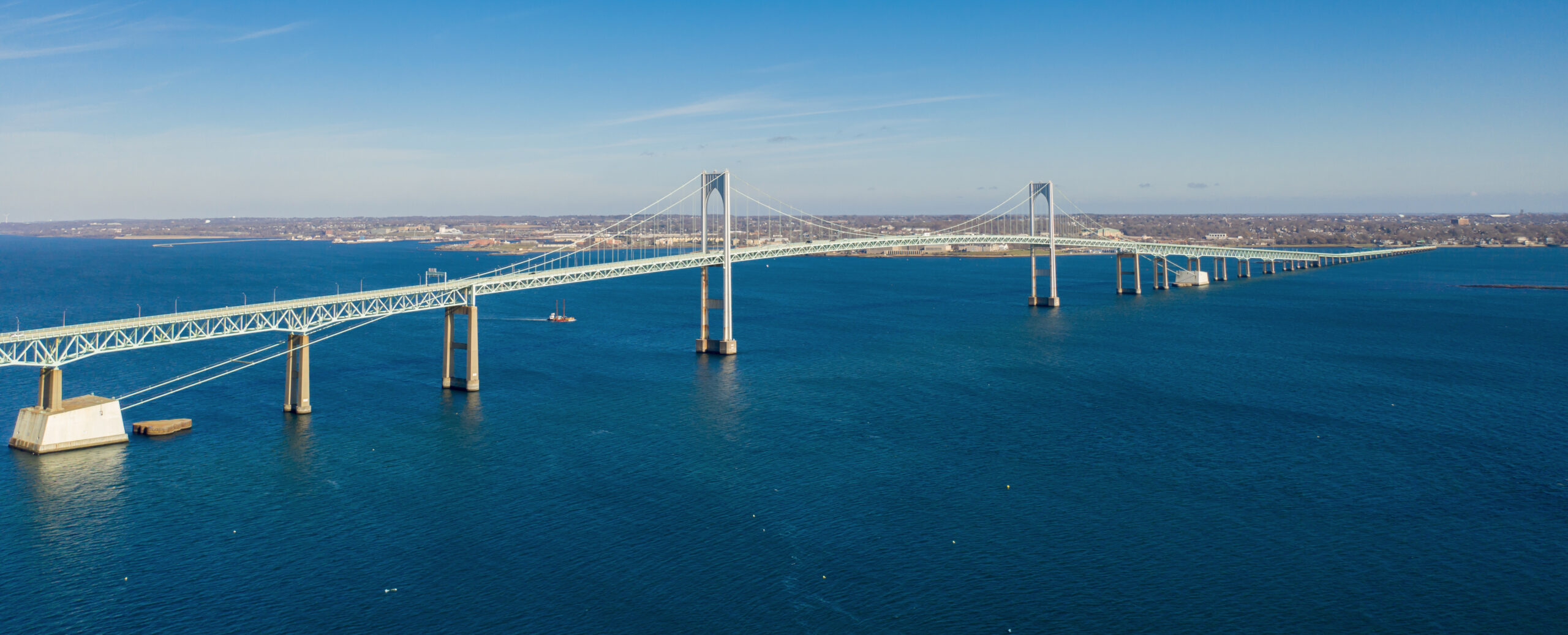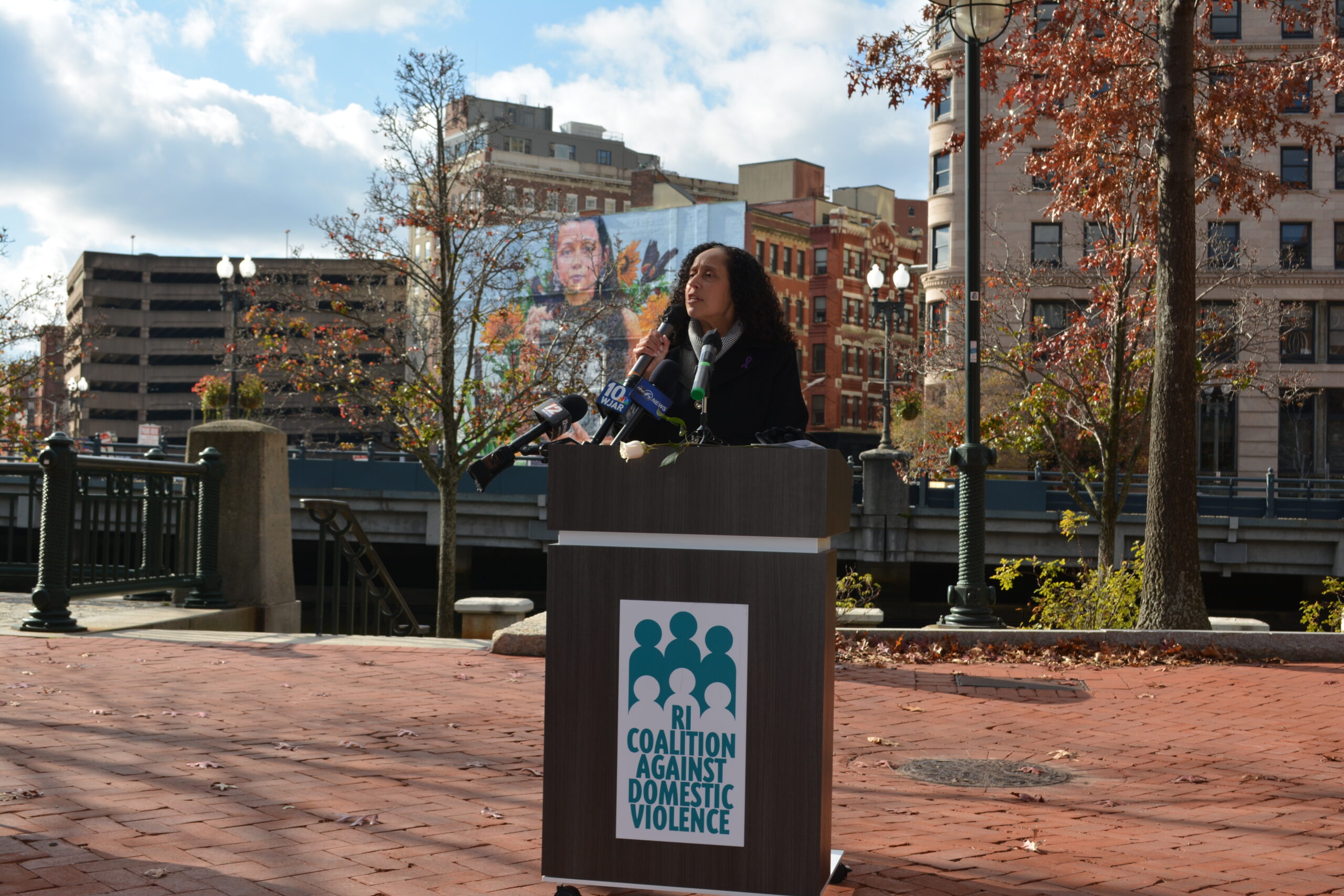
Suicide prevention, with a focus on deaths from Rhode Island bridges, has become your passion. What inspired you to undertake this work?
My inspiration to do suicide prevention work and advocate for safety bridge barriers comes from the day I was unable to stop a man from ending his life and witnessing his suicide jump from Rhode Island’s Mount Hope Bridge. This experience cultivated a strong desire to expose the high prevalence of bridge suicide in Rhode Island and push for accountability and change to a nearly 100-year-old public safety issue.
Can you share your experience as a witness to bridge suicide?
In 2016, on a cold, windy February day I stopped my car on the center span of Rhode Island’s Mount Hope Bridge to help a man I thought was having car problems. Unfortunately, it became clear very quickly his car wasn’t disabled and his intention was to kill himself by jumping off the bridge. There are specific details about that day I will always remember like the subzero wind chill temperature, the ice on top of the 35-inch-high railing, and watching this man struggle to remain standing with each strong gust of wind while my car rocked back and forth. There are other details that are forever imprinted in my memory like the sound of my car’s horn that I used to divert his attention away from the low railing, the glazed over expression on his face, the hopelessness and pain in his eyes, the words we exchanged as we looked into each other’s eyes and of course his final moments on the bridge railing.
When he started to make his way to the railing I got out of my car but the wind gusts were too strong so I decided to stay in my car. I continued speaking to him thru the passenger side open window. At this point he was squatting on top of the bridge railing holding the tower cable with his right hand and staring down at the water. When I yelled out to him he turned and looked into my eyes again. I asked him to please come down off the railing. He said something to me that I couldn’t hear over the howling wind and shook his head NO. Still in his squatting position, he turned his head and body back toward the water letting go of the tower cable and pushed off. I called 911 and remained on top of the bridge for another hour speaking with the police and filling out an incident report while watching the first responders be blown around as they clung to their cars and the bridge cables searching the waters below for the body.
A friend who was in my car immediately went into emotional shock. He and I didn’t speak or see each other for weeks following this day. I wanted to talk about what happened but he wanted to forget it. Several months after the jump he told me I probably saved HIS life by stopping him from getting out of the car. He said he has often thought about how easily he could have been pulled over the railing but continues to feel a deep sadness for not saving him and for all the pain and suffering it has caused the man’s family. We both still wish we could change the outcome of that day on the bridge.
After the jump I spent the next several months searching for answers and solace, questioning every action and non-action I made that day. I went over so many what ifs, should haves, and could haves in my mind.
About a month after the jump, I started giving public talks about my experience, read a lot of research studies on bridge suicide, and spoke to as many people as I could about the prevalence of suicide by bridge in our community. The more I talked about it, the more people who came forward to tell their stories. The stories were coming from not only the family and friends of those lost to bridge suicide but the witnesses, co-workers, neighbors, and many first responders. I soon discovered that suicide from RI bridges happens far more often than what gets reported. The people who shared their stories wanted something done to make the 4 suicide bridges in Newport County safe and so did I.
In July 2016, I started an advocacy group and online media presence with three mission goals: 1) Advocate for the installation of safety/suicide prevention barriers on Rhode Island bridges; 2) Provide research-based information to the public in order to raise awareness of the prevalence of bridge suicide in Rhode Island, dispel myths about suicide and suicide prevention, and eradicate mental health stigma; 3) Offer support, hope, and resources to all affected by bridge suicide.
A focus of the group you head, RI Bridging the Gap, is installation of safety barriers and nets on Rhode Island’s four tallest bridges: Pell/Newport, Jamestown Verrazzano, Mount Hope and Sakonnet River. Why are they needed?
Safety barriers and nets are a proven suicide deterrent. They physically block access to this lethal means which allows time for an intervention, time for the suicidal crisis to pass, and time for the suicidal person to return to a mindset where safer coping strategies can be considered. People in suicidal crisis have tunnel vision and believe ending their life is the only way out of their pain. Even though a suicidal crisis is a temporary state of mind, it can come on quickly and the time between deciding to end one’s life and taking action is often very short. This is a time of great risk and the reason why bridge barriers and nets are so important. We must protect people by preventing access to this lethal means of suicide. The four bridges here in Newport County are highly lethal. The side railings are extremely low and unsafe for every person who travels over them, especially those who are struggling and the witnesses and first responders who hope to save them. If barriers or nets were in place, the deaths of hundreds of people could have been prevented. The lives of thousands of people would not have been traumatically impacted. The grief, pain, and suffering that come to the families, friends, witnesses, first responders, and others with each loss of life is massive. Witnesses and first responders are left to deal with the traumatic impact of watching someone take their life and/or a body recovery. Their lives are also in danger because there’s nothing to prevent them from falling off the bridge while helping someone.
What would you say to those who would maintain that safety barriers and nets would not save lives – that people who seek to lose their lives by suicide jumps would find other means?
It’s a misconception that people who are suicidal will find another way if deterred for example by bridge barriers. This is called method or means substitution and the research data shows this rarely happens. Studies do support that once deterred most individuals do not later go on to die by suicide. People don’t usually change method during a suicide crisis. However if a suicide attempt does occur, other methods are likely to be less lethal. A suicidal crisis can be intense but it is usually temporary. A bridge barrier by design creates a pause. The railings on these bridges take little to no effort to get over and are too accessible. If we remove the means, we automatically reduce suicide rates. The answer to saving lives is quite simple: Put barriers up on bridges so people can’t jump or fall off them! It’s really that simple.
Why haven’t they been installed yet?
I wish there was an easy answer to this question because then the solution would likely be just as easy. I think there are many reasons the barriers haven’t been installed yet. Most of them in my opinion are unwarranted and the ones that have some validity should have been addressed decades ago. In general people are resistant to change and the fear of what change could mean. Public resistance to safety barriers is rooted in things such as change in aesthetics, but a lot of it stems from a lack of understanding around suicide and suicide prevention. Mental health stigma and myths about suicide are also factors. Both perpetuate judgment and discrimination against people who have experience with and losses due to suicide. If a child fell off the bridge or a police officer or a motor vehicle, I bet we would see immediate outrage and a prioritized urgency to install safety barriers. If there were numerous road or highway fatalities due to some kind of engineering failure to road infrastructure, I bet we would see a quick response to fix it. But when hundreds of suicide jumps occur from RI bridges with railings as low as 35 inches in height and no safety barriers, the response to rectify this issue is slow at best and not prioritized. Providing factual evidence-based information about suicide and suicide prevention to the public, including our legislators and Rhode Island Turnpike and Bridge Authority, is an important step in eliminating this double standard.
RITBA is a quasi-public agency that manages the four bridges in Newport County for the state of Rhode Island. This has created some stumbling blocks to getting barriers up. Historically, RITBA has been ambivalent and noncommittal about addressing bridge suicide despite hundreds of confirmed jumps over the years, nearly a decade of advocacy, and four years of introduced legislation. It has only been the push of increased public awareness, advocacy groups, and proposed legislation that any momentum has happened at all. Currently, Rhode Island still does not have temporary or permanent safety barriers on its four suicide bridges. The Sunshine Skyway Bridge in Tampa is operated by the Florida Department of Transportation. After pleas from advocacy groups and numerous suicides from the bridge, the FDOT installed vertical nets to deter further suicides. No legislation was required to mandate these barriers and it was funded by the toll system from the bridge. The netting system on the Golden Gate Bridge in San Francisco was partially funded by revenues from their bridge authority, the Golden Gate Bridge District, and other sources including federal funding. In 2012, President Barack Obama signed into law an act including language allowing federal funds to be used on the Golden Gate Bridge suicide prevention barrier project. In Massachusetts, funding for barriers on the French King Bridge is being secured through MassDOT and a transportation bill. The lack of barriers on RI’s existing bridges is clearly an infrastructure safety issue, yet millions of dollars in federal funding recently given to RITBA to improve bridge infrastructure and safety is not being used to fund the feasibility study or being set aside for the installation of temporary and permanent barriers. It’s required that older buildings be brought up to code when undergoing major reconstruction. Bridge construction and repairs need to be held to a similar standard.
The Rhode Island Current recently reported that RITBA Executive Director Lori Caron Silveira said in a letter that the state’s proposal mandates an unrealistic timeline for the work involved in the barrier feasibility study. The RI Current also reported that Senator Lou DiPalma stated he plans to revise the timeframe in his bill to be more realistic, but emphasized the need to get barriers up as soon as possible. One example of a similar barrier feasibility study for the Quechee Gorge Bridge in Vermont was completed in eight months. Suicide from Rhode Island bridges goes as far back to when these bridges were first built. It was over six years ago when I first asked RITBA to do a feasibility/design study and install safety barriers on the bridges they manage.
Since then, I and others have continued to ask them to address this decades-old problem. We attended several Authority board meetings where we were told studies needed to be done to determine engineering factors such as weight limits. We were also told they would look into applying for grants, federal money, and bridge revenues to cover the costs of the study and the barriers. However, there was no movement toward the goal of installing barriers. It has been the tireless efforts of advocates and finally legislative efforts to push things in the right direction. The state of Rhode Island and RITBA have had more than an adequate amount of time to address and fix this problem which would eliminate suicide from these bridges. The legislative process is working, but too slowly. RITBA has known about this longstanding problem long before I started asking them to do something about it and before the recently introduced legislative bills. In response to the executive director’s statement about an unrealistic timeline, I say the authority has had decades to rectify this problem. The study for the Mount Hope and Jamestown Verrazzano bridges began in January 2023 with a projected completion time of about one year. So it does not seem unrealistic to me that construction on at least one of these two bridges could have begun by the bills’ timeline date of June 30, 2024. It is also noteworthy to mention Atkins proposal to study all 4 bridges was 1.5 million.
Because the 2023 Rhode Island state budget earmarked just 1 million to RITBA for it, RITBA decided to choose two of the four bridges to study while they waited for the state to give them the remaining $500,000. Atkins, a British multi-national engineering company, was ready to begin the study of Mt Hope and Jamestown Verrazzano bridges in Fall 2022 but had to wait for RITBA to give approval and eventually they started in January 2023. Each day of delay could mean another loss of life. There were at least 4 bridge jumps and an unknown number of jump attempts from October 2022 to December 2022. It remains to be seen how many more people will die while we wait for the study of all four bridges to be completed. A lot more money has been invested in highway and other bridge safety improvements than what the barrier study will cost (1.5 million to study all four bridges) or proposed cost for the actual barriers or nets (approx. 30 million for all four bridges).
Temporary barriers or fencing installed on other bridges cost a small fraction of the money needs for permanent barriers. In 2015 RITBA finally installed and paid for median barriers on the Pell Bridge to prevent crossover collisions after years of strong advocating from area residents, resolutions from surrounding town officials calling on RITBA to install the median barrier, three deaths due to crossover collisions between June 2011 to December 2013, and a lawsuit against the Authority. Although median barriers to prevent cross-over collisions are a worthy safety investment, the number of deaths from bridge suicides has been much higher in comparison. The number of bridge suicides alone is enough to warrant urgent attention to installing suicide prevention barriers as soon as possible. Installing safety barriers show the community and the world Rhode Island cares about their safety and cares about putting an end to bridge suicide in our state. Historically, the lack of decisive leadership and urgency on this issue has led to the death of hundreds of people and many more left behind to deal with these losses. It is long past time for the state of Rhode Island and the RITBA to commit to putting suicide prevention barriers or nets in place and commit to implementing them with the sense of urgency it deserves.
What would House Bridge Barrier Bill H6002 and the companion Senate Bill S586 accomplish?
The two companion bills, as written, mandate the RITBA to design a safety barrier or netting system on the Mount Hope, Claiborne Pell, and Jamestown Verrazzano bridges by January 1, 2024, with construction commencing no later than June 30, 2024. If passed, the bills would hold RITBA responsible to have the feasibility study with options completed and construction of barriers or nets started within a specified timeframe.
What happened with the bridge barrier bills in the General Assembly this session?
As passed in this year’s legislative session by the House Finance committee, $750,000 is being earmarked in the 2024 state budget to complete a feasibility study, including options, for safety barriers for the Claiborne Pell and Sakonnet River Bridges. This money is in addition to $1 million earmarked in the 2023 state budget to do a feasibility study for safety barriers for the Jamestown Verrazzano and Mt Hope Bridges. This budget appropriation will stop the passage of bills H6002 and S586. Although securing money needed to complete the study of all four bridges is another step in the right direction, it does fall very short of what is truly needed. Continued delays mean continued loss of life. If such delays are going to continue to occur, the state of Rhode Island needs to take emergency action mandating RITBA to put up a temporary barriers or nets while we wait for the permanent ones to be installed. An example of a temporary barrier is lightweight steel mesh fencing. A special legislative session of the Rhode Island General Assembly could be convened to address this urgent issue. Temporary and permanent bridge barriers are not novel ideas. Many U.S. states and other areas around the world have put up temporary barriers to keep people safe while waiting for the installation of permanent barriers.
Can you give us an overview of the number of lives lost by bridge jumping in recent years?
Since 2016, I have confirmed over 40 bridge jumps from the four bridges in Newport County. Specifically from November 2020 to November 2021, RI Bridging the Gap confirmed 13 bridges jumps. The total loss of life by bridge suicide in Rhode Island is hard to know. The number of people traumatically impacted by each jump is immeasurable. I have worked with families that lost loved ones as recent as a month ago to more than 30 years ago. I’ve heard stories from first responders who have gone on response calls for recent jumps as well as going back decades. Data on jump numbers and jump attempts are not readily available to the public. Response calls by police and fire are not centrally recorded so response by one department doesn’t necessarily guarantee knowledge of the jump by other departments. Jumps not witnessed or caught on camera sometimes don’t get recorded as suicides. If a body is not recovered, it is not recorded as a suicide.
There are other things in addition to these examples that can skew the numbers. All of them make tracking jumps challenging. Over the years, mostly due to increased public awareness and social media, information on jumps often gets passed along by community members, news stations, journalists, family members and friends of jumpers, obituaries, first responders, and other ways. RITBA likely has the most accurate number of jumps occurring from the four bridges due to their camera systems, assuming they are in working order. It’s very likely the jumps I confirm are far less than the actual number of jumps. This lack of transparency falsely minimizes the scope of this issue. It bears mentioning that response calls for jump attempts are also high in Newport County. This places our first responders in unnecessary danger as well as witnesses and other drivers on the bridges. The financial and manpower resources used to respond to confirmed jumps and attempts are resources that could be used for other emergencies if safety bridge barriers were put on these bridges.
Last December, I missed witnessing another jump on the Mount Hope by a few minutes but I was present for the police, fire, and marine rescue and helped scan the bay looking for the person in the water. Marine Rescue finally found him and rushed him to Newport Hospital where he was pronounced dead. One police department reported on average anywhere from 10 to 20 responses for jumpers a year for the past ten years on one of the bridges and a quick look back beyond this capture sees the data consistent historically. These numbers do not include police response to the same bridge by the police department located on the other side of the bridge. The tragic loss of life, the lifelong impact of these jumps on family, witnesses and first responders adds once again to the high cost of delaying installation of safety barriers another day.
And what is an estimate of how many lives would be saved by safety barriers and nets?
If we’re seeing on average one jump a month, the number of lives saved would be enormous. Suicide from bridges drastically declines and in many cases, is completely eliminated after suicide prevention barriers or nets are installed. This has been shown at numerous locations in the U.S. and around the world. A few examples include the Sunshine Skyway Bridge in Tampa Bay Florida, Bourne and Sagamore Bridges in Cape Cod MA, Memorial Bridge in Augusta ME, and Bloor Street Viaduct Bridge, Toronto Canada. Decades of research supports bridge barriers as the optimal means for preventing suicide from bridges. One of the most comprehensive position papers about suicide prevention on bridges was compiled by the National Suicide Prevention Lifeline (now called the 988 Suicide and Crisis Lifeline). Suicide prevention advocates, transportation authorities, legislators and other decision-makers have been positively influenced by the thorough, evidence-based data in this paper. Here’s the link to The National Suicide Prevention Lifeline Position – 2017.
A study was initiated by the Vermont Agency of Transportation following legislation passed in the 2016 session to review suicide prevention alternatives and safety measures at the Quechee Gorge Bridge. The study began May 2016 and was completed December 2016. I didn’t have to read far into this comprehensive 128 page report before being taken back by the first of several shocking statements. On page 5 in the Executive Summary it states “The Quechee Gorge Bridge has been the site of 15 suicides since 2003, about one per year on average.” When compared to the number of bridge suicides we are seeing here in Newport County Rhode Island, our numbers are much higher. My personal tracking of jumps from the four bridges in recent years averages about one per month. However, I’ve been told by first responders from area departments that my numbers are low. I have often wondered how many lives need to be destroyed before barriers become a priority in Rhode Island. One life lost is too many and I congratulate the state of Vermont for getting this done. Here’s the link to the Quechee Gorge Bridge Safety Issues Suicide Prevention Study.
You have spoken with and counseled many people who have lost relatives and friends to suicide. Tell us about the emotions they continue to feel after losing a loved one.
Bridge suicide rips apart the lives of those left behind to live with the pain. For every person who loses their life to bridge suicide, there are hundreds more affected by that one loss. If you multiply the hundreds of lives lost to bridge suicide in Rhode Island by the hundreds of lives affected by each one, it is easy to see the unfortunate scope of this problem. Many of the bridge suicide loss survivors I have spoken with have suffered tremendous hardships in direct relationship to losing a loved one, being a witness, or first responder to these preventable tragedies. Some of the loss survivors are all three, having lost a loved one as well as being a witness and first responder.
The people left behind suffer in many ways. Some suffer financial difficulties such as loss of income due to the death of their loved one or the inability to maintain employment due to their grief. Some feel forced to move or relocate out of state in an attempt to avoid painful memories and avoid seeing or having to travel over the suicide bridges. Some have suffered from substance abuse trying to numb the pain as well as depression, PTSD, and anxiety. Some describe an unfillable hole in their lives and hearts, sleepless nights, strained relationships, missed anniversaries, birthdays, and holidays. Some struggle to continue living, to get out of bed, or to raise the children left behind. There are some emotions that are commonly experienced like anguish, feeling numb, feeling isolated, feeling empty, helplessness, hopelessness, anger, regret, sadness and guilt.
Guilt is often felt because the loss survivors somehow think they should have been able to prevent the jump. Anger is sometimes directed at the person who jumped or onto themselves, but most often there’s anger because there were no barriers to prevent their loved one from jumping. They are angry the barriers are still not up. They hurt more every time another jump occurs. They don’t want another family to go through what they endure. I can relate to some of the emotions especially helplessness, sadness, guilt, and anger. Being an advocate and supporting other bridge suicide loss survivors has helped my own healing. I’ve prayed to the man that died jumping off the bridge that day and told myself and his family how sorry I am that I couldn’t save him. I promised to save as many others as I can. My heart breaks every time another person jumps off one of the bridges. Every time I tell my story, I relive the experience. It can be difficult. Many others affected by bridge suicide have shared their stories numerous times as well including testifying at the Senate and House hearings for the legislative bills. Some of them have testified four years in a row. The physical and emotional toll on them is huge. I’m amazed every day by their strength.
What are some of the things you have offered to bridge suicide loss survivors to support them?
Bridge suicide loss survivors can reach out any time via Messenger, Facebook, email, text, phone, or any other outlet used by RI Bridging the Gap to ask questions, just to talk, get information about available resources, and for help understanding the legislative process.
RI Bridging the Gap’s Facebook page keeps its followers up to date on advocacy activities, progress, and events. It provides information regarding bridge barrier legislation, relevant research data on bridge suicide, and suicide prevention. It’s a place where people can share ideas, ask questions, connect with other bridge suicide loss survivors and get support. Other social media outlets include RI Bridging the Gap’s YouTube Channel, Twitter and Instagram accounts.
A Remembrance Vigil was held on April 30, 2023 to remember those lost to bridge suicide in RI and to give comfort and hope to all affected by these losses. In May 2023, a private Facebook support group was launched called Healing Conversations: for all affected by bridge suicide.
Tell us a bit about yourself aside from your suicide prevention efforts.
I was born and raised in Newport County and still live here. My family and friends are here. This community means a lot to me and I’ll do whatever I can to keep it safe and beautiful for everyone to enjoy. After college I worked as a clinical social worker and was drawn to holistic health care. I own Aquidneck Massage and Healing Arts where I practice massage therapy, energy healing, spiritual counseling, meditation instruction, and hypnosis. In 2021, I became a licensed RN. Some of my favorite self-care activities include walking in nature, losing track of time exploring wooded trails, kayaking, listening to people tell stories about the good old days, and being a foster mom for Save A Lab Rescue.
Anyone in immediate danger should call 911.
Call 988 if you are having thoughts of suicide or in crisis. 988 is free, available 24/7, and confidential.
Other resources:
● BHLink: For confidential support and to get connected to care, call (401) 414-LINK (5465) or visit the BHLink 24-hour/7-day triage center at 975 Waterman Ave., East Providence. Website: bhlink.org
● The Samaritans of Rhode Island: (401) 272-4044 or (800) 365-4044. Website: samaritansri.org
● The Crisis Text Line: Text HOME to 741741 “from anywhere in the USA, anytime, about any type of crisis.”
● Butler Hospital Behavioral Health Services Call Center: Available 24/7 “to guide individuals seeking advice for themselves or others regarding suicide prevention.” (844) 401-0111






